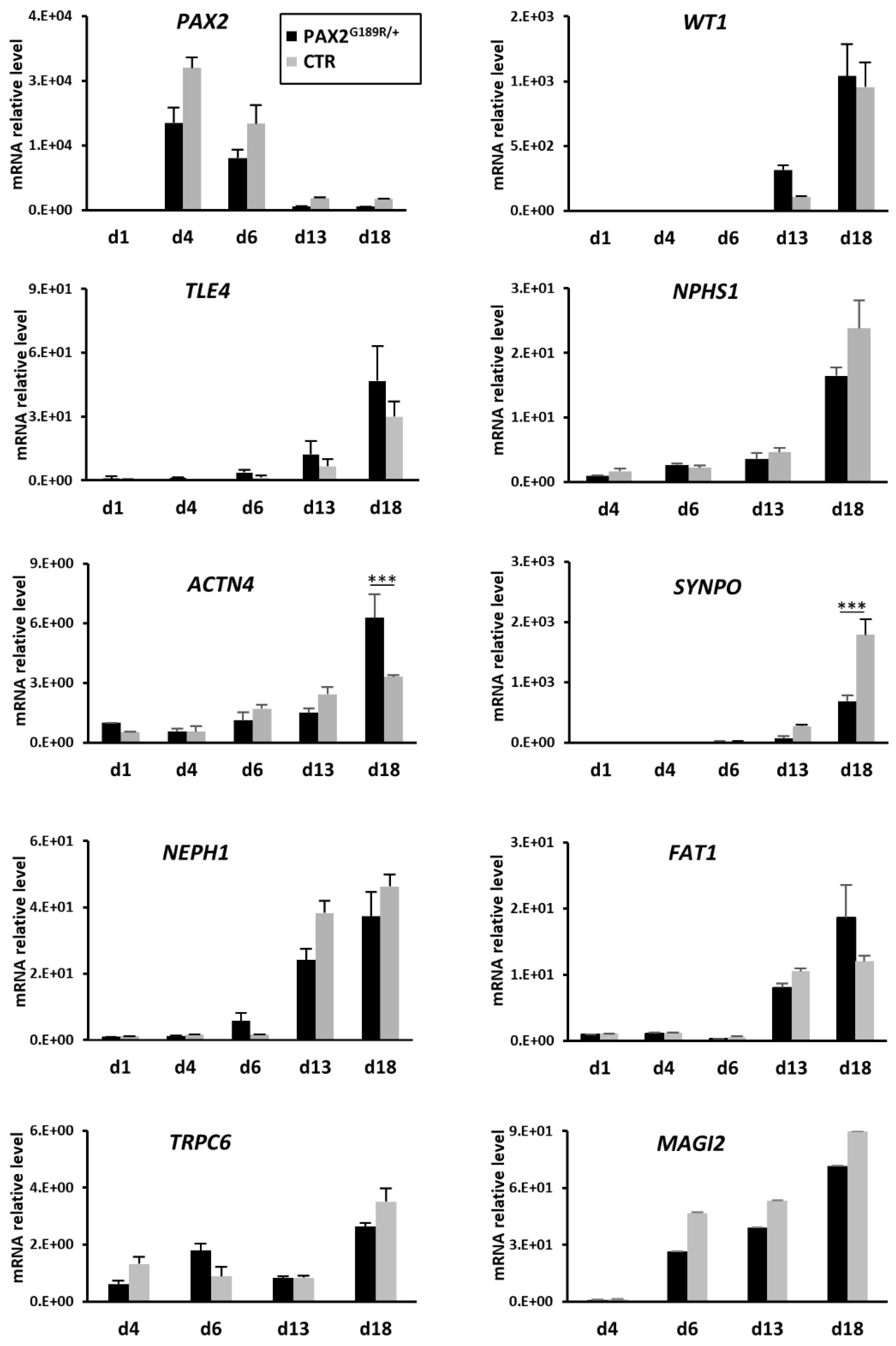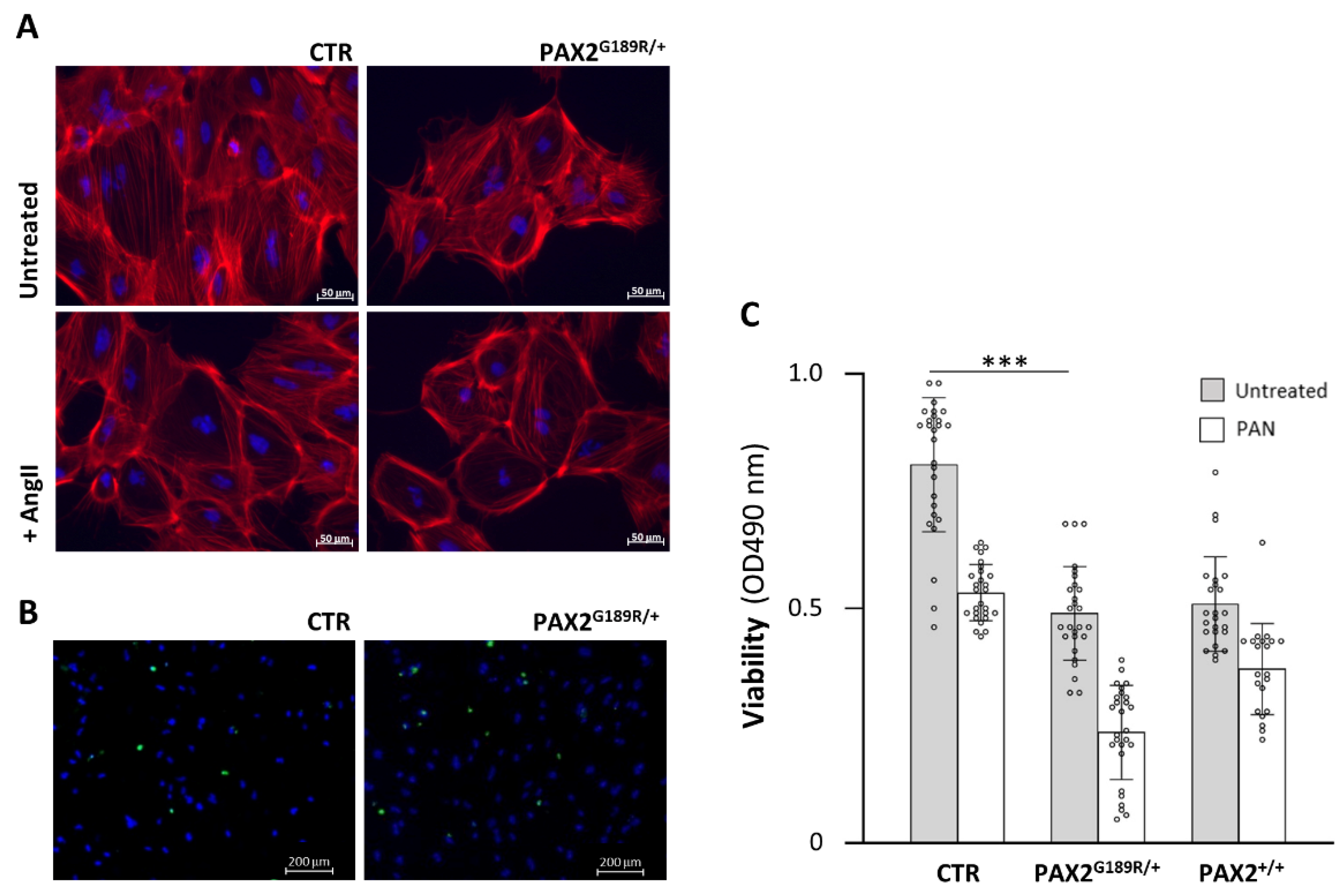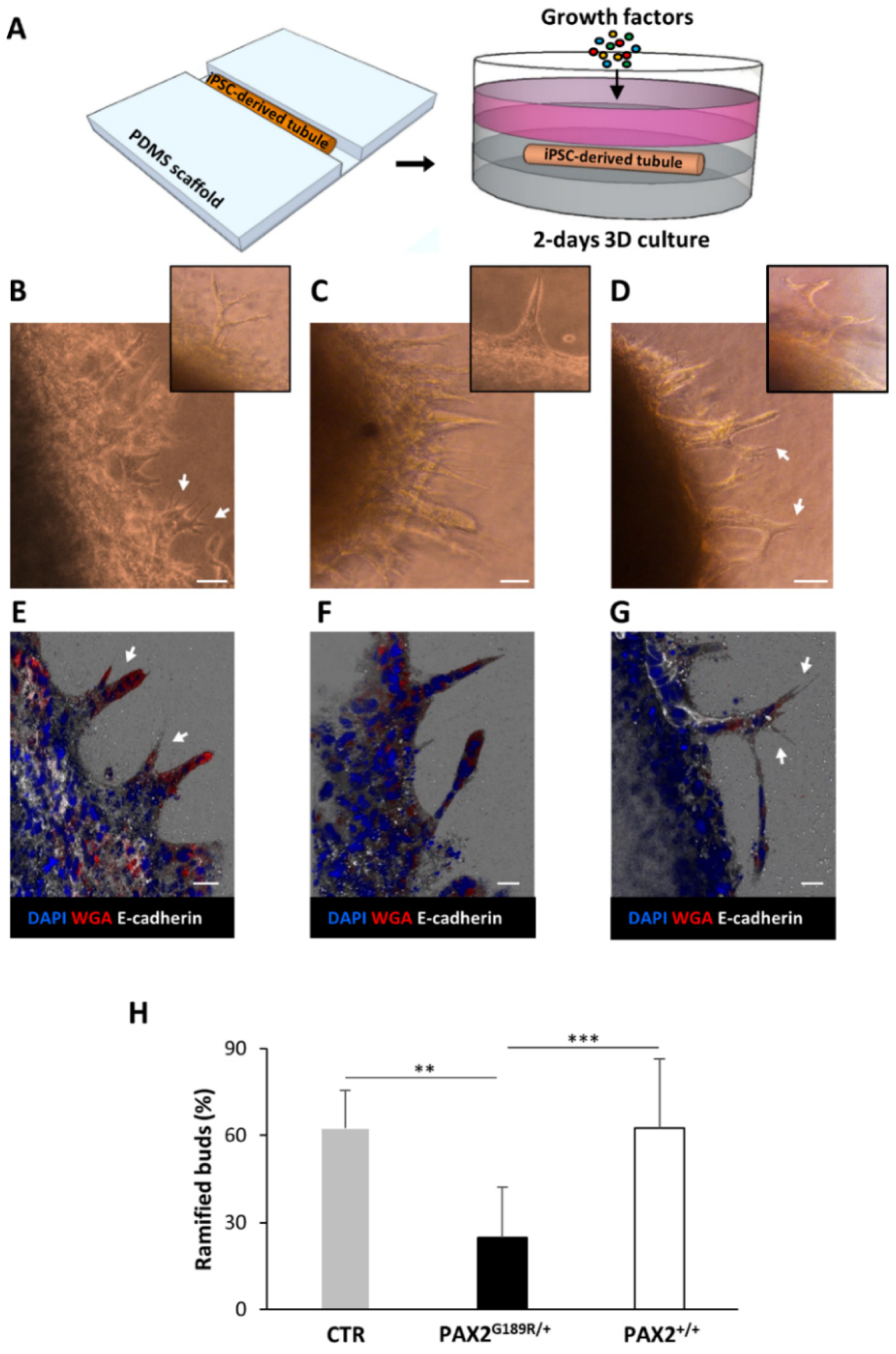Unravelling the Role of PAX2 Mutation in Human Focal Segmental Glomerulosclerosis
Abstract
:1. Introduction
2. Materials and Methods
2.1. Patient and Healthy Control
2.2. Human iPSC-Derived Podocytes Culture and Treatments
2.3. Gene Expression Analysis
2.4. Immunofluorescence Analysis
2.5. Genome-Wide Differential Gene Expression Analysis
2.6. Albumin Uptake Assay
2.7. Cell Viability Assay
2.8. Enzyme-Linked Immunosorbent Assay
2.9. Differentiation of iPSCs toward Ureteric Bud (UB) Progenitor-like Cells and Tubule Engineering
2.10. Statistical Analysis
3. Results
3.1. Generation and Characterization of PAX2G189R/+ iPSC-Derived Podocytes
3.2. Functional Properties of PAX2G189R/+ iPSC-Derived Podocytes
3.3. Gene Expression Signature of Control and PAX2G189R/+ iPSC-Derived Podocytes
3.4. Correction of G189R-PAX2 Restores Ureteric Bud Morphogenesis Potential
4. Discussion
Supplementary Materials
Author Contributions
Funding
Institutional Review Board Statement
Informed Consent Statement
Data Availability Statement
Acknowledgments
Conflicts of Interest
References
- Sadowski, C.E.; Lovric, S.; Ashraf, S.; Pabst, W.L.; Gee, H.Y.; Kohl, S.; Engelmann, S.; Vega-Warner, V.; Fang, H.; Halbritter, J.; et al. A single-gene cause in 29.5% of cases of steroid-resistant nephrotic syndrome. J. Am. Soc. Nephrol. 2015, 26, 1279–1289. [Google Scholar] [CrossRef] [PubMed] [Green Version]
- Perico, N.; Benigni, A.; Remuzzi, G. Present and future drug treatments for chronic kidney diseases: Evolving targets in renoprotection. Nat. Rev. Drug Discov. 2008, 7, 936–953. [Google Scholar] [CrossRef] [PubMed]
- Jefferson, J.A.; Shankland, S.J. The pathogenesis of focal segmental glomerulosclerosis. Adv. Chronic Kidney Dis. 2014, 21, 408–416. [Google Scholar] [CrossRef] [Green Version]
- Kopp, J.B.; Anders, H.-J.; Susztak, K.; Podestà, M.A.; Remuzzi, G.; Hildebrandt, F.; Romagnani, P. Podocytopathies. Nat. Rev. Dis. Primers 2020, 6, 68. [Google Scholar] [CrossRef] [PubMed]
- Barua, M.; Stellacci, E.; Stella, L.; Weins, A.; Genovese, G.; Muto, V.; Caputo, V.; Toka, H.R.; Charoonratana, V.T.; Tartaglia, M.; et al. Mutations in PAX2 associate with adult-onset FSGS. J. Am. Soc. Nephrol. 2014, 25, 1942–1953. [Google Scholar] [CrossRef] [PubMed] [Green Version]
- Trionfini, P.; Ciampi, O.; Todeschini, M.; Ascanelli, C.; Longaretti, L.; Perico, L.; Remuzzi, G.; Benigni, A.; Tomasoni, S. CRISPR-Cas9-Mediated Correction of the G189R-PAX2 Mutation in Induced Pluripotent Stem Cells from a Patient with Focal Segmental Glomerulosclerosis. CRISPR J. 2019, 2, 108–120. [Google Scholar] [CrossRef] [PubMed]
- Dressler, G.R.; Woolf, A.S. Pax2 in development and renal disease. Int. J. Dev. Biol. 1999, 43, 463–468. [Google Scholar]
- Sharma, R.; Sanchez-Ferras, O.; Bouchard, M. Pax genes in renal development, disease and regeneration. Semin. Cell Dev. Biol. 2015, 44, 97–106. [Google Scholar] [CrossRef] [PubMed]
- Ciampi, O.; Iacone, R.; Longaretti, L.; Benedetti, V.; Graf, M.; Magnone, M.C.; Patsch, C.; Xinaris, C.; Remuzzi, G.; Benigni, A.; et al. Generation of functional podocytes from human induced pluripotent stem cells. Stem Cell Res. 2016, 17, 130–139. [Google Scholar] [CrossRef] [PubMed] [Green Version]
- Love, M.I.; Huber, W.; Anders, S. Moderated estimation of fold change and dispersion for RNA-seq data with DESeq2. Genome Biol. 2014, 15, 550. [Google Scholar] [CrossRef] [PubMed] [Green Version]
- Chen, E.Y.; Tan, C.M.; Kou, Y.; Duan, Q.; Wang, Z.; Meirelles, G.V.; Clark, N.R.; Ma’ayan, A. Enrichr: Interactive and collaborative HTML5 gene list enrichment analysis tool. BMC Bioinform. 2013, 14, 128. [Google Scholar] [CrossRef] [Green Version]
- Xinaris, C.; Benedetti, V.; Novelli, R.; Abbate, M.; Rizzo, P.; Conti, S.; Tomasoni, S.; Corna, D.; Pozzobon, M.; Cavallotti, D.; et al. Functional Human Podocytes Generated in Organoids from Amniotic Fluid Stem Cells. J. Am. Soc. Nephrol. 2016, 27, 1400–1411. [Google Scholar] [CrossRef] [PubMed] [Green Version]
- Benedetti, V.; Brizi, V.; Guida, P.; Tomasoni, S.; Ciampi, O.; Angeli, E.; Valbusa, U.; Benigni, A.; Remuzzi, G.; Xinaris, C. Engineered Kidney Tubules for Modeling Patient-Specific Diseases and Drug Discovery. EBioMedicine 2018, 33, 253–268. [Google Scholar] [CrossRef] [PubMed]
- Saleem, M.A.; O’Hare, M.J.; Reiser, J.; Coward, R.J.; Inward, C.D.; Farren, T.; Xing, C.Y.; Ni, L.; Mathieson, L.W.; Mundel, P. A conditionally immortalized human podocyte cell line demonstrating nephrin and podocin expression. J. Am. Soc. Nephrol. 2002, 13, 630–638. [Google Scholar] [CrossRef]
- Pippin, J.W.; Brinkkoetter, P.T.; Cormack-Aboud, F.C.; Durvasula, R.V.; Hauser, P.V.; Kowalewska, J.; Krofft, R.D.; Logar, C.M.; Marshall, C.B.; Ohse, T.; et al. Inducible rodent models of acquired podocyte diseases. Am. J. Physiol. Renal. Physiol. 2009, 296, F213–F229. [Google Scholar] [CrossRef] [PubMed]
- Bridgewater, D.J.; Ho, J.; Sauro, V.; Matsell, D.G. Insulin-like growth factors inhibit podocyte apoptosis through the PI3 kinase pathway. Kidney Int. 2005, 67, 1308–1314. [Google Scholar] [CrossRef] [Green Version]
- Garg, P. A Review of Podocyte Biology. Am. J. Nephrol. 2018, 47 (Suppl. 1), 3–13. [Google Scholar] [CrossRef] [PubMed]
- Eccles, M.R.; He, S.; Legge, M.; Kumar, R.; Fox, J.; Zhou, C.; French, M.; Tsai, R.W.S. PAX genes in development and disease: The role of PAX2 in urogenital tract development. Int. J. Dev. Biol. 2002, 46, 535–544. [Google Scholar]
- Remuzzi, A.; Conti, S.; Ene-Iordache, B.; Tomasoni, S.; Rizzo, P.; Benigni, A.; Remuzzi, G. Role of ultrastructural determinants of glomerular permeability in ultrafiltration function loss. JCI Insight 2020, 5, 137249. [Google Scholar] [CrossRef] [PubMed]
- Sachs, N.; Sonnenberg, A. Cell-matrix adhesion of podocytes in physiology and disease. Nat. Rev. Nephrol. 2013, 9, 200–210. [Google Scholar] [CrossRef] [PubMed]
- Fujinaka, H.; Katsuyama, K.; Yamamoto, K.; Nameta, M.; Yoshida, Y.; Yaoita, E.; Tomizawa, S.; Yamamoto, T. Expression and localization of insulin-like growth factor binding proteins in normal and proteinuric kidney glomeruli. Nephrology 2010, 15, 700–709. [Google Scholar] [CrossRef]
- Bach, L.A.; Hale, L.J. Insulin-like growth factors and kidney disease. Am. J. Kidney Dis. 2015, 65, 327–336. [Google Scholar] [CrossRef] [PubMed]
- Haffner, D.; Grund, A.; Leifheit-Nestler, M. Renal effects of growth hormone in health and in kidney disease. Pediatr. Nephrol. 2021, 36, 2511–2530. [Google Scholar] [CrossRef] [PubMed]
- Sever, S.; Schiffer, M. Actin dynamics at focal adhesions: A common endpoint and putative therapeutic target for proteinuric kidney diseases. Kidney Int. 2018, 93, 1298–1307. [Google Scholar] [CrossRef] [PubMed]
- Blaine, J.; Dylewski, J. Regulation of the Actin Cytoskeleton in Podocytes. Cells 2020, 9, 1700. [Google Scholar] [CrossRef] [PubMed]
- Dziarmaga, A.; Eccles, M.; Goodyer, P. Suppression of Ureteric Bud Apoptosis Rescues Nephron Endowment and Adult Renal Function in Pax2 Mutant Mice. J. Am. Soc. Nephrol. 2006, 17, 1568–1575. [Google Scholar] [CrossRef] [PubMed] [Green Version]







| Catalog Number | Gene Symbol | Description |
| Hs99999909_m1 | HPRT1 | Hypoxanthine phosphoribosyltransferase 1 |
| Hs01057416_m1 | PAX2 | Paired box 2 |
| Hs00240913_m1 | WT1 | Wilms tumor 1 |
| Hs00702468_s1 | SYNPO | Synaptopodin |
| Hs00989190_m1 | TRPC6 | Transient receptor potential cation channel subfamily C member 6 |
| RefSeq | Gene Symbol | Sequence 5′-3′ |
| NM_000194.2 | Hs HPRT1 | Fwd: GGCAGTATAATCCAAAGATGGTCA Rev: TCCTTTTCACCAGCAAGCTTG |
| NM_016932 | Hs SIX2 | Fwd: CTTGCCACCGTTCATTCT Rev: GGACCAGGACACAGAGTA |
| NM_0013515421 | Hs TLE4 | Fwd: CCATCATTGGGCAGCAACAAC Rev: CTACCGATGGGTGGAATGGC |
| NM_004646.3 | Hs NPHS1 | Fwd: GGCCACAGCCAGGGTGA Rev: ATGGGGGCCTCCAGTGC |
| NM_004924.4 | Hs ACTN4 | Fwd: GCCCGATCTCCTCCATCTTG Rev: CCCTGGATGAACTTAGAGCCC |
| NM_005245.3 | Hs FAT1 | Fwd: CCTCACGGTCATGGTACGAG Rev: AAACCCGCCCTTTGTAGGAG |
| NM_001286349.1 | Hs NEPH1 | Fwd: AGGTGCCGCTCTATGTGAAC Rev: TTCCAGGCCCATGCTATGC |
| NM_012301.3 | Hs MAGI2 | Fwd: AAGTAGGCAACAAGTGCCACC Rev: GCCAAATCCAGACTCCATCCT |
| NM_001111283.2 | Hs IGF1 | Fwd: TGTACTTCAGAAGCAATGGGAA Rev: TGGTGTGCATCTTCACCTTCA |
| Antibody | Source | Catalog Number | Working Dilution |
|---|---|---|---|
| Alpha-Actinin 4 | Origene | TA307264 | 1:200 |
| CD2AP | Santa Cruz | SC-9137 | 1:300 |
| CDH3 | R&D System | MAB861 | 1:100 |
| Integrin linked ILK | Abcam | ab76468 | 1:100 |
| NPHS1 | Santa Cruz | SC-28192 | 1:100 |
| P-cadherin | R&D System | MAB861 | 1:50 |
| Paxillin | Genetex | GTX125891 | 1:200 |
| Synaptopodin | Abcam | ab101883 | 1:100 |
| TLE4 | Santa Cruz | SC-365406 | 1:150 |
| WT1 | R&D System | AF5729 | 1:50 |
| ZO-1 | Invitrogen | 61-7300 | 1:100 |
Publisher’s Note: MDPI stays neutral with regard to jurisdictional claims in published maps and institutional affiliations. |
© 2021 by the authors. Licensee MDPI, Basel, Switzerland. This article is an open access article distributed under the terms and conditions of the Creative Commons Attribution (CC BY) license (https://creativecommons.org/licenses/by/4.0/).
Share and Cite
Longaretti, L.; Trionfini, P.; Brizi, V.; Xinaris, C.; Mele, C.; Breno, M.; Romano, E.; Giampietro, R.; Remuzzi, G.; Benigni, A.; et al. Unravelling the Role of PAX2 Mutation in Human Focal Segmental Glomerulosclerosis. Biomedicines 2021, 9, 1808. https://doi.org/10.3390/biomedicines9121808
Longaretti L, Trionfini P, Brizi V, Xinaris C, Mele C, Breno M, Romano E, Giampietro R, Remuzzi G, Benigni A, et al. Unravelling the Role of PAX2 Mutation in Human Focal Segmental Glomerulosclerosis. Biomedicines. 2021; 9(12):1808. https://doi.org/10.3390/biomedicines9121808
Chicago/Turabian StyleLongaretti, Lorena, Piera Trionfini, Valerio Brizi, Christodoulos Xinaris, Caterina Mele, Matteo Breno, Elena Romano, Roberta Giampietro, Giuseppe Remuzzi, Ariela Benigni, and et al. 2021. "Unravelling the Role of PAX2 Mutation in Human Focal Segmental Glomerulosclerosis" Biomedicines 9, no. 12: 1808. https://doi.org/10.3390/biomedicines9121808






